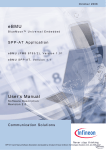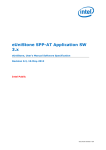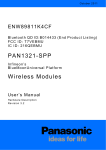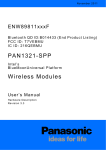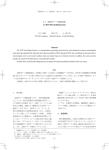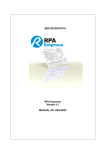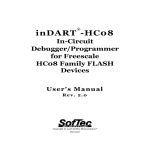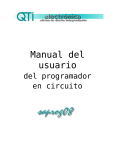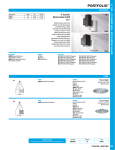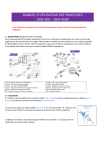Download Intel Mobile Communications - Panasonic Industrial Devices
Transcript
eB M U BlueMoon™ Universal Embedded SP P- AT A pplic ati on eBMU PMB 8753/2 Version 1.01 eBMU SPP-AT Image Us er 's Ma nual Software Description Revision 5.0, 2011-09-05 Intel Mobile Communications Wirel es s Solu tions Intel Corporation has recently acquired certain portions of Infineon Technologies AG and is in the process of converting documents to the Intel format. Please bear with us during this transition and direct any questions or issues to your sales rep or to IMC-DOC. INFORMATION IN THIS DOCUMENT IS PROVIDED IN CONNECTION WITH INTEL PRODUCTS. NO LICENSE, EXPRESS OR IMPLIED, BY ESTOPPEL OR OTHERWISE, TO ANY INTELLECTUAL PROPERTY RIGHTS IS GRANTED BY THIS DOCUMENT. EXCEPT AS PROVIDED IN INTEL'S TERMS AND CONDITIONS OF SALE FOR SUCH PRODUCTS, INTEL ASSUMES NO LIABILITY WHATSOEVER AND INTEL DISCLAIMS ANY EXPRESS OR IMPLIED WARRANTY, RELATING TO SALE AND/OR USE OF INTEL PRODUCTS INCLUDING LIABILITY OR WARRANTIES RELATING TO FITNESS FOR A PARTICULAR PURPOSE, MERCHANTABILITY, OR INFRINGEMENT OF ANY PATENT, COPYRIGHT OR OTHER INTELLECTUAL PROPERTY RIGHT. UNLESS OTHERWISE AGREED IN WRITING BY INTEL, THE INTEL PRODUCTS ARE NOT DESIGNED NOR INTENDED FOR ANY APPLICATION IN WHICH THE FAILURE OF THE INTEL PRODUCT COULD CREATE A SITUATION WHERE PERSONAL INJURY OR DEATH MAY OCCUR. Intel may make changes to specifications and product descriptions at any time, without notice. Designers must not rely on the absence or characteristics of any features or instructions marked “reserved” or “undefined”. Intel reserves these for future definition and shall have no responsibility whatsoever for conflicts or incompatibilities arising from future changes to them. The information here is subject to change without notice. Do not finalize a design with this information. The products described in this document may contain design defects or errors known as errata which may cause the product to deviate from published specifications. Current characterized errata are available on request. Contact your local Intel sales office or your distributor to obtain the latest specifications and before placing your product order. Copies of documents which have an order number and are referenced in this document, or other Intel literature, may be obtained by calling 1-800-548-4725, or go to: http://www.intel.com/#/en_US_01. Any software source code reprinted in this document is furnished under a software license and may only be used or copied in accordance with the terms of that license. [When the doc contains software source code, include a copy of the software license or a hyperlink to its permanent location.] This document contains information on products in the design phase of development. Intel processor numbers are not a measure of performance. Processor numbers differentiate features within each processor family, not across different processor families. Go to: http://www.intel.com/products/processor%5Fnumber/. Code Names are only for use by Intel to identify products, platforms, programs, services, etc. (“products”) in development by Intel that have not been made commercially available to the public, i.e., announced, launched or shipped. They are never to be used as “commercial” names for products. Also, they are not intended to function as trademarks. BunnyPeople, Celeron, Celeron Inside, Centrino, Centrino Inside, Core Inside, i960, Intel, the Intel logo, Intel AppUp, Intel Atom, Intel Atom Inside, Intel Core, Intel Inside, the Intel Inside logo, Intel NetBurst, Intel NetMerge, Intel NetStructure, Intel SingleDriver, Intel SpeedStep, Intel Sponsors of Tomorrow., the Intel Sponsors of Tomorrow. logo, Intel StrataFlash, Intel Viiv, Intel vPro, Intel XScale, InTru, the InTru logo, InTru soundmark, Itanium, Itanium Inside, MCS, MMX, Moblin, Pentium, Pentium Inside, skoool, the skoool logo, Sound Mark, The Journey Inside, vPro Inside, VTune, Xeon, and Xeon Inside are trademarks of Intel Corporation in the U.S. and other countries. *Other names and brands may be claimed as the property of others. Copyright © 2011, Intel Corporation. All rights reserved. eBMU PMB 8753/2 eBMU Revision History: 2011-09-05, Revision 5.0 Previous Revision: 2010-04-28, Rev. 4.1 Page Subjects (major changes since last revision) 16 Length of uuid parameter in AT+JRLS command depends on the used SPP-AT SW version. 20 The timing of Stream Connection Cancel string is more tolerant in SPP-AT v1.7 and onwards. 25-26 New section 4.11 GPIO Indication of Connection Status Trademarks of Infineon Technologies AG BlueMoon™, COMNEON™, C166™, CROSSAVE™, CanPAK™, CIPOS™, CoolMOS™, CoolSET™, CORECONTROL™, DAVE™, EasyPIM™, EconoBRIDGE™, EconoDUAL™, EconoPACK™, EconoPIM™, EiceDRIVER™, EUPEC™, FCOS™, HITFET™, HybridPACK™, ISOFACE™, I²RF™, IsoPACK™, MIPAQ™, ModSTACK™, my-d™, NovalithIC™, OmniTune™, OptiMOS™, ORIGA™, PROFET™, PRO-SIL™, PRIMARION™, PrimePACK™, RASIC™, ReverSave™, SatRIC™, SensoNor™, SIEGET™, SINDRION™, SMARTi™, SmartLEWIS™, TEMPFET™, thinQ!™, TriCore™, TRENCHSTOP™, X-GOLD™, XMM™, X-PMU™, XPOSYS™. Other Trademarks Advance Design System™ (ADS) of Agilent Technologies, AMBA™, ARM™, MULTI-ICE™, PRIMECELL™, REALVIEW™, THUMB™ of ARM Limited, UK. AUTOSAR™ is licensed by AUTOSAR development partnership. Bluetooth™ of Bluetooth SIG Inc. CAT-iq™ of DECT Forum. COLOSSUS™, FirstGPS™ of Trimble Navigation Ltd. EMV™ of EMVCo, LLC (Visa Holdings Inc.). EPCOS™ of Epcos AG. FLEXGO™ of Microsoft Corporation. FlexRay™ is licensed by FlexRay Consortium. HYPERTERMINAL™ of Hilgraeve Incorporated. IEC™ of Commission Electrotechnique Internationale. IrDA™ of Infrared Data Association Corporation. ISO™ of INTERNATIONAL ORGANIZATION FOR STANDARDIZATION. MATLAB™ of MathWorks, Inc. MAXIM™ of Maxim Integrated Products, Inc. MICROTEC™, NUCLEUS™ of Mentor Graphics Corporation. Mifare™ of NXP. MIPI™ of MIPI Alliance, Inc. MIPS™ of MIPS Technologies, Inc., USA. muRata™ of MURATA MANUFACTURING CO., MICROWAVE OFFICE™ (MWO) of Applied Wave Research Inc., OmniVision™ of OmniVision Technologies, Inc. Openwave™ Openwave Systems Inc. RED HAT™ Red Hat, Inc. RFMD™ RF Micro Devices, Inc. SIRIUS™ of Sirius Sattelite Radio Inc. SOLARIS™ of Sun Microsystems, Inc. SPANSION™ of Spansion LLC Ltd. Symbian™ of Symbian Software Limited. TAIYO YUDEN™ of Taiyo Yuden Co. TEAKLITE™ of CEVA, Inc. TEKTRONIX™ of Tektronix Inc. TOKO™ of TOKO KABUSHIKI KAISHA TA. UNIX™ of X/Open Company Limited. VERILOG™, PALLADIUM™ of Cadence Design Systems, Inc. VLYNQ™ of Texas Instruments Incorporated. VXWORKS™, WIND RIVER™ of WIND RIVER SYSTEMS, INC. ZETEX™ of Diodes Zetex Limited. Last Trademarks Update 2010-03-22 Template: IFX_Template_2009-11-10.dot eBMU PMB 8753/2 Table of Contents Table of Contents 1 Introduction ........................................................................................................................................ 5 2 Bluetooth Features............................................................................................................................. 6 3 3.1 3.1.1 3.1.2 3.2 Serial Port Profile ............................................................................................................................... 7 Operation Modes .................................................................................................................................. 7 Command Mode ................................................................................................................................... 7 Stream Mode ........................................................................................................................................ 7 Pin Assignments................................................................................................................................... 7 4 4.1 4.1.1 4.1.2 4.1.2.1 4.1.2.1.1 4.1.2.1.2 4.2 4.3 4.4 4.5 4.5.1 4.5.2 4.6 4.7 4.8 4.9 4.10 4.11 Infineon SPP-AT Command and Response ..................................................................................... 9 AT Command and Response Format and Syntax ............................................................................... 9 AT Commands ..................................................................................................................................... 9 AT Responses ...................................................................................................................................... 9 AT Response Parameter List for <status> and <ERROR> ............................................................... 10 Command Execution Status Values................................................................................................... 10 General Error Messages .................................................................................................................... 10 AT Command List Table .................................................................................................................... 11 AT Responses List (not command triggered) .................................................................................... 21 Crystal Auto Calibration (Frequency counter method) ....................................................................... 22 Low Power Mode Control ................................................................................................................... 22 Host Initiates Low Power Mode Entry and Exit .................................................................................. 23 Host Initiates Low Power Mode Entry, eBMU Initiates Exit ............................................................... 23 UART Baud Rate Change .................................................................................................................. 24 Data Flow Control............................................................................................................................... 25 Production Mode ................................................................................................................................ 25 SPP-AT Commands Operating with EEPROM .................................................................................. 25 Security Mode .................................................................................................................................... 25 GPIO Indication of Connection Status ............................................................................................... 25 5 Example AT Commands and Responses ...................................................................................... 27 References............................................................................................................................................................ 30 Terminology ......................................................................................................................................................... 31 User's Manual Software Description 4 Revision 5.0, 2011-09-05 eBMU PMB 8753/2 Introduction 1 Introduction This document describes the AT commands applicable to Infineon’s eBMU Bluetooth solution for embedded applications. The product utilizes a raw AT set of commands and responses over UART for Bluetooth communications and control on an embedded device. User's Manual Software Description 5 Revision 5.0, 2011-09-05 eBMU PMB 8753/2 Bluetooth Features 2 • • • • • • • • • • • • • • Bluetooth Features Bluetooth v2.0 + EDR compliant. Device A and B support 1 ACL link with stream or command mode. Device A and B - Visible while connected. Device A and B - Visible/connectable when not connected. Device A and B - Device Discovery capable after receiving OK on data transfer. Sniff mode is supported with above capabilities. 5 trusted devices stored in EEPROM. Testing Enable DUT. Crystal calibration. H4 with UART HW flow control (RTS/CTS). Security modes Mode 1 and Mode 3. Master-Slave role switch User's Manual Software Description 6 Revision 5.0, 2011-09-05 eBMU PMB 8753/2 Serial Port Profile 3 Serial Port Profile Host communication sent over UART is always called command except while in stream mode, see below. All communication received by host application over UART is called response except while in stream mode. 3.1 Operation Modes The specification defines two operation modes of the PMB 8753/2 also named eBMU throughout the document. For Bluetooth SPP there are two different roles specified; A-device (paging device) setting up the over the air connection and B-device which is connectable and accepts the connection (page scanning device). 3.1.1 Command Mode In this mode the SPP application running on the eBMU will execute the AT commands sent from the host over the UART using the H4 UART protocol as specified within the Bluetooth SIG [1]. In this mode, the host application can send data to the eBMU, which are transmitted to the remote device which has a Bluetooth connection on SPP level with the eBMU. This mode is normally used when transmitting burst and packetized data. Setting up/accepting Bluetooth SPP connections and/or searching for other Bluetooth devices are also operations done in this mode. 3.1.2 Stream Mode In this mode, the host application will send un-packetized data to the eBMU, which are transmitted over the air to the remote device. This mode is normally used when transmitting small size of data in a random way and for serial cable replacement applications. 3.2 Pin Assignments The table below shows the available GPIOs. GPIOs noted with “(Reserved)” can not be controlled by a host. P0.1 and P0.8 can be used as application GPIOs but not when they are used during the crystal calibration procedure. All application GPIOs are by default configured as tri-state. User's Manual Software Description 7 Revision 5.0, 2011-09-05 eBMU PMB 8753/2 Serial Port Profile Pin Name Default Configuration Direction GPIO Description UART_RX UART_TX UART_RTS UART_CTS I O PU O PU I I O O I P0.5 (Reserved) P0.4 (Reserved) P0.6 (Reserved) P0.7 (Reserved) UART UART UART UART SDA SCL O PU I PU I/O I P0.12 (Reserved) P0.13 (Reserved) I2C I2C PCMFR1 TX_Conf2 O PU I O I P0.0 (Reserved) P0.14 (Reserved) LPM LPM PCMCLK PCMIN PCMOUT PAON PSEL0 PSEL1 TX_Conf1 P015 Z Z Z Z Z Z Z Z I/O I/O I/O I/O I/O I/O I/O I/O P0.1 P0.2 P0.3 P0.8 P0.9 P0.10 P0.11 P0.15 APPL GPIO / XTAL CAL APPL GPIO APPL GPIO APPL GPIO / XTAL CAL APPL GPIO APPL GPIO APPL GPIO APPL GPIO User's Manual Software Description 8 Revision 5.0, 2011-09-05 eBMU PMB 8753/2 Infineon SPP-AT Command and Response 4 Infineon SPP-AT Command and Response AT commands can only be sent while in command mode with the exception of stream connection cancel (^^^) which can be sent in stream mode. The expected response after sending an AT command is the “OK” response, see specification below. The host shall wait for a command to be terminated before sending a new one. A command is considered as terminated when “OK” and all subsequent related responses have been received. There are also responses, which are not initiated by a sent command. They are in that case initiated by the remote Bluetooth device. 4.1 AT Command and Response Format and Syntax All data exchanged between the host and eBMU is in ASCII format. Parameters for commands and responses are given in decimal (DEC) base in ASCII format unless hexadecimal (HEX) base is specified. MSB is always sent first. eBMU does not distinguish between upper and lower cases. Example for values with decimal base in ASCII format The number 255 in decimal corresponds to three characters ‘2’, ‘5’, ‘5’. E.g. AT+JSDA=010,1234567890. Here the number 10 must be given by three ASCII characters ‘0’, ‘1’, ‘0’, because the parameter requires a value consisting of three characters. Example for values with hexadecimal base in ASCII format The number 255 in decimal base corresponds to the number FF in hexadecimal base, thereby the number in ASCII format for hexadecimal base is represented by the following two characters ‘F’, ‘F’. E.g. +RSNFCNF=3E80,2. The four ASCII characters ‘3’, ‘E’, ‘8’, ‘0’ represent the number 3E80 in hexadecimal base which corresponds to 16000 in decimal base. 4.1.1 AT Commands All AT-commands follow the format below; AT+<command>=<parameter 1 (if required)>,<parameter 2 (if required)>,<parameter 3 (if required)>,<…><carriage return><line feed> E.g.: AT+JCCR=0010c64d67dc,01 (To connect to BD_ADDR 0x0010c64d67dc, service channel 1) 4.1.2 AT Responses All AT-responses follow the format below with the exception of <OK> and <ERROR=>; +<response>=<parameter 1 (if required)>,<parameter 2 (if required)>,<parameter 3 (if required)>,<…><carriage return><line feed> E.g.: +RDAI =004,DATA (4 bytes “DATA” received) User's Manual Software Description 9 Revision 5.0, 2011-09-05 eBMU PMB 8753/2 Infineon SPP-AT Command and Response 4.1.2.1 4.1.2.1.1 AT Response Parameter List for <status> and <ERROR> Command Execution Status Values Values for <status> general for all commands • • • BT_OK BT_ERROR BT_TIMEOUT 4.1.2.1.2 • • 1. 2. 3. 4. 5. 6. 7. 8. 0 1 4 General Error Messages ERR = -1; Syntax Error ERR = -2; Command not allowed at present execution status − ERR=-2 is obtained when any of the following situations is met: Create a new connection when already connected. Device discovery when already connected. Send data when not connected. Accept connection request without a request. Enter sniff mode without being connected. Enable SEC mode after another command has previously been sent. Service discovery when connected. Send data with length = 0. User's Manual Software Description 10 Revision 5.0, 2011-09-05 eBMU PMB 8753/2 Infineon SPP-AT Command and Response 4.2 AT Command List Table AT Command Usage Resulting response(s) from eBMU OK AT+JAAC=<auto_accept> Auto Accept Connection requests Forces eBMU to accept connection requests. Dev A / Dev B Dev B OK Dev B Crystal Auto Calibrate +RCACCNF=<osc_trim> Dev A Dev B trim_value parameter (4 characters / HEX base): The trim value is used to adjust the frequency on the GPIO chosen by the GPIO parameter. GPIO parameter (4 characters / HEX base): Two GPIOs can be used as output for the oscillator trim, P01 and P08 (0002 and 0100). See section 4.4. osc_trim parameter(4 characters / HEX base) auto_accept parameter (1 character ): 0 Host will be notified on incoming connection indication (+RCOI) – (no auto accept). Default value 1 eBMU will automatically auto accept incoming connection request – (host will be notified but connection is accepted automatically) AT+JACR=<accept> Accept Connection Request Shall be used as answer to a connect indication (+RCOI). accept parameter (1 character): 0 Not accepted 1 Accepted AT+JCAC=<trim_value>, <GPIO > Use AT+JCBD to store the osc_trim value to EEPROM. Note: AT+JCAC command can only be issued after production mode is enabled (AT+JPRO=1). See section 4.8. AT+JCBD=<bd_data> OK Change BD_Data Dev A Dev B bd_data parameter (116 characters / HEX base / LSB first): The bd_data string consists of following configuration data (with reference value): bdAddr (12 characters) = see Note 1 channelWordOffset (4 characters) = 0000 clkConf (2 characters) = 8A User's Manual Software Description 11 Revision 5.0, 2011-09-05 eBMU PMB 8753/2 Infineon SPP-AT Command and Response AT Command Usage Resulting response(s) from eBMU Dev A / Dev B eepromSize (2 characters) = 80 inputFreq (8 characters) = 80BA8C01 lmpFeatures (16 characters) = BF02067E98190000 lpmConf (2 characters) = 40 lpmDrift (2 characters) = FA lpmThreshold (2 characters) = 12 ulpmThreshold (2 characters) = 18 pmuConfig (4 characters) = 8000 rfPselD (8 characters) = 03040506 rfPselConf (2 characters) = 44 rssiMin (2 characters) = 0C rssiMax (2 characters) = 10 ddcTlConf (2 characters) = 02 uartBaudrate (2 characters) = 04 uartInvert (2 characters) = 00 uartPulls (2 characters) = 01 oscSettle (2 characters) = 10 bbConf (2 characters) = 04 rfConf (2 characters) = 04 txPowerRef0 (2 characters) = F2 txPowerRef1 (2 characters) = F8 txPowerRef2 (2 characters) = FE txPowerRef3 (2 characters) = 04 oscTrim (4 characters) = see Note 2 threeWireArqTimeout (2 characters) = 06 lmpVersion (2 characters) = 00 reserved (16 characters) = 0000000000000000 Note: 1. The bdAddr is pre-programmed on eUniStone module. It can be read through AT+JRBD. Don’t overwrite the pre-programmed value accidentally. 2. The oscTrim value is pre-programmed on eUniStone module. It can be read through AT+JRBD. Writing a wrong value can destroy the module. 3. AT+JCBD command can only be issued after production mode is enabled (AT+JPRO=1). Changes in BD Data take place after production mode command is disabled (AT+JPRO=0) followed by a SW reset (AT+JRES). See section 4.8. User's Manual Software Description 12 Revision 5.0, 2011-09-05 eBMU PMB 8753/2 Infineon SPP-AT Command and Response AT Command Usage AT+JCCR=<bd_addr>, <service channel> Create Connection Request Instructs eBMU to connect to a remote Bluetooth device (prospective slave). bd_addr parameter (12 characters / HEX base): The Bluetooth address of the remote device service_channel parameter (2 characters / DEC base): Value range: 01-30 Which service channel to connect to can be received from a Service Discovery (AT+JSDS) AT+JDDS=<limit_inquiry _result> Device Discovery Start Causes eBMU to start a Device Discovery (Inquiry and Remote Name Request) of the Bluetooth neighborhood. limit_inquiry_result parameter (1 character): Value range: 0-1. The maximum number of responses that can be obtained is 8. Note: Value of the limit_inquiry_result parameter have no impact in the behavior of the command. AT+JDIS=<discoverable> DIScoverable Forces eBMU into Page Scan / Inquiry Scan states indefinitely (note: this makes the device discoverable). discoverable parameter (1 character): 0 No scans enabled. 1 Inquiry Scan enabled. User's Manual Software Description 13 Resulting response(s) from eBMU OK (Followed by): +RCCRCNF=<MTU_size >,<status> Dev A / Dev B Dev A MTU_size parameter (3 characters / DEC base) status parameter (1 character): See section 4.1.2.1.1. If maximum number of allowed connections already exists: ERR=-2. OK Dev A (Then, if responses are returned): +RDDSRES=< bd_addr >, <remote_name>,<COD> (For each response) bd_addr parameter (12 characters / HEX base). remote_name parameter (variable length): Name of the remote device. Page Timeout is received as a name if the remote name is not found during device discovery COD parameter (6 characters / HEX base): Class of device (Completed by): +RDDSCNF=<status> status parameter (1 character): See section 4.1.2.1.1. OK Dev B Dev A is discoverable but does not accept incoming connections. Revision 5.0, 2011-09-05 eBMU PMB 8753/2 Infineon SPP-AT Command and Response AT Command Usage Resulting response(s) from eBMU Dev A / Dev B OK after command is sent. Dev A Dev B 2 Page Scan enabled. 3 Inquiry & Page Scan enabled. Note: Default value after a HW reset is no scans enabled AT+JDOI DOwnload Application Image via UART After “OK” response a binary file with the EEPROM image should be sent. File open and send in binary format after “OK” is received. Note: AT+JDOI command can only be issued after production mode is enabled (AT+JPRO=1). Changes in the EEPROM image are effective after production mode command is disabled (AT+JPRO=0) followed by a HW reset. See section 4.8. AT+JEDT Enable Device under Test This SPP-AT command enables the device under test. After this command has been sent it is possible for a remote tester to connect, this AT command corresponds to the three different HCI commands listed below: 1. Set Event Filter – allow all connections. 2. Write Scan Enable – page and Inquiry. 3. Enable device under test. +RDOICNF after .eep file has been written. Note: eBMU calculates the size of the image that is being downloaded from the file header. The response +RDOICNF is generated when the calculated size is reached. OK Dev A Dev B +GPOACNF=<value> Dev A Dev B Note: AT+JEDT command can only be issued with security mode 1 and after is enabled production mode (AT+JPRO=1). See section 4.8. AT+JGPA=<reserved>, <read>, <set>,<clear> GPIO action All parameters of this command are bit fields of 16 bits corresponding to GPIOs P0.15 to P0.0. E.g. if pin P0.0 is the desired bit; the bit field value is 0001 and if the desired bit is P0.12 the bit field value is 0800. reserved parameter (4 characters) read parameter (4 characters / Hex base): Values for each bit: 0 No Action 1 Read User's Manual Software Description 14 value parameter (4 characters / HEX base): This value is the state of the GPIO PINs specified in read parameter. Values for each bit: 0 Low 1 High When the pins are set as outputs the return Revision 5.0, 2011-09-05 eBMU PMB 8753/2 Infineon SPP-AT Command and Response AT Command Usage set parameter (4 characters / HEX base): Values for each bit: 0 No Action 1 Set clear parameter (4 characters / HEX base): Values for each bit: 0 No Action 1 Clear AT+JGPC= <direction>,<open_drain>, <pull_on/off>, <pull_up/down>,<tristate> GPIO Configuration All parameters of this command are bit fields of 16 bits corresponding to GPIOs P0.15 to P0.0 (See command AT+JGPA). direction parameter (4 characters / HEX base): Values for each bit: 0 OUT 1 IN open_drain parameter (4 characters / HEX base): Values for each bit: 1 OPEN pull_on/off parameter (4 characters / HEX base): Values for each bit: 0 Pull OFF 1 Pull ON pull_up/down parameter (4 characters / HEX base): Value for each bit: 1 Pull UP 0 Pull DOWN tristate parameter (4 characters / HEX base): Value for each bit: 1 Tri-state Resulting response(s) from eBMU value will be 0 for the specific pin. Dev A / Dev B Reserved pins will always return 0. OK Dev A Dev B OK (Followed by): +RSLE if secure link is established Dev A Dev B Note: See section 3.2 for available GPIO pins. AT+JPCR=<length_PIN_ code>, <PIN_code> PIN Code Reply Sent to eBMU in response to a PIN Code Request from a remote Bluetooth device (bd_addr). length_PIN_code parameter (2 characters / DEC base): Value range: 01-16 Length of PIN code User's Manual Software Description 15 Revision 5.0, 2011-09-05 eBMU PMB 8753/2 Infineon SPP-AT Command and Response AT Command Usage Resulting response(s) from eBMU Dev A / Dev B OK Dev A Dev B Dev A Dev B Dev B PIN_code parameter (length= length_PIN_code): The PIN Code to be sent to the remote Bluetooth device, e.g. AT+JPCR=04,1234 Note: The PIN code is an ACII string. AT+JPRO=<mode> PROduction mode mode parameter (1 character): 0 Production mode OFF 1 Production mode ON Note: See section 4.8 for commands requiring production mode. AT+JRBD Read Bluetooth device Data Sent to eBMU to retrieve the Bluetooth Device Address and the Oscillator trimming value. AT+JRES RESet SW reset of the system. +RRBDRES=<bd_addr>, < oscTrim> bd_addr parameter (12 characters / HEX base): BD Address of remote device oscTrim parameter (4 characters / HEX base) Oscillator trim value ROK as applications is restarted. AT+JRLS=<uuid>, <length_ service_name > <service_name>,<service channel >, <CoD> Register Local Service OK User's Manual Software Description Dev A Dev B uuid parameter: uuid for supported profile With SPP-AT v1.x: 4 characters / HEX base e.g.1101 for Serial Port Profile With SPP-AT v2.x: 32 characters / HEX base e.g. 0000110100001000800000805f9b34fb for Serial Port Profile length_service_name parameter (2 characters / DEC base): Value range: 01-16 Length of service name service_name parameter (length= length_service_name): Name for the service, no final delimiter is needed service channel parameter (2 characters / DEC base): Value range: 01-30 Which service channel to connect to can be 16 Revision 5.0, 2011-09-05 eBMU PMB 8753/2 Infineon SPP-AT Command and Response AT Command Usage Resulting response(s) from eBMU Dev A / Dev B <revision> revision parameter (2 characters / HEX base) OK Dev A Dev B OK Dev A Dev B OK Dev A Dev B received from a Service Discovery with AT+JSDS. CoD parameter (6 characters / HEX base): Class of device. The default CoD value is 000000 Note: AT+JRRI AT+JRTD=<bd_addr> AT+JSCR AT+JSDA=<length>, <data> 1. You may not register more than one service. 2. This command should be sent if DevB behavior is required. Read Revision Information Remove Trusted Device Delete the trusted device information for a registered device (bd_addr). bd_addr parameter (12 characters / HEX base): The Bluetooth address of the device that shall be removed from the list. <bd_addr>=000000000000: Delete all trusted devices. Stream Connection Request Connects the SPP and UART streams, transparent communication will be enabled if both sides execute this command. Send Data Request Dev A Dev B length parameter (3 characters / DEC base): number of bytes to be sent Value range: 001 to max .MTU size data parameter (see note for size): Data to be sent Note: Maximum number of bytes for each packet is reported at connection confirmation (MTU_Size). The value for this parameter is negotiated by the two devices during connection set up. AT+JSDR SPP Disconnect Request Forces an SPP disconnection. OK Dev A Dev B AT+JSDS=<bd_addr>, < uuid> Service Discovery Start Causes eBMU to start a service discovery of device with bd_addr and search for services defined by uuid. OK (Then, if services are returned): +RSDSRES= Dev A User's Manual Software Description 17 Revision 5.0, 2011-09-05 eBMU PMB 8753/2 Infineon SPP-AT Command and Response AT Command Usage bd_addr parameter (12 characters / HEX base): BD Address of remote device uuid parameter ( 4 characters / HEX base): Service to search for e.g. 1101 for Serial Port Profile AT+JSEC= <security_mode>, <Link_key_information>, <PIN_type>, <length_PIN_code>, <PIN_code> Resulting response(s) from eBMU <remote_service_name>, <remote_service_channel > remote_service_name parameter (variable length): Name of the remote service. remote_service_channel parameter (2 characters / DEC base) (For each service) (Completed by): +RSDSCNF=<status> status parameter (1 character) OK Enable SECurity Dev A / Dev B Dev A Dev B security_mode parameter (1 character): 1 Security Mode 1 2 N/A 3 Security Mode 3 (default) link_key_information parameter (1 character): 1 2 Note: This parameter has no function. It has to be set to either 1 or 2. PIN_type parameter (1 character) 1 Variable PIN (default) 2 Fixed PIN length_PIN_code parameter (2 characters / DEC base): Length of PIN code. The maximum PIN length value is 16 ( corresponding to a 16 characters long PIN code) PIN_code parameter (length=length_PIN_code): Normal user PIN, for example “0000” (default), This parameter is taken into account if PIN_TYPE is fixed. Note: If security mode shall be changed from default settings, AT+JSEC shall be the first command that is sent after a reset. Security mode 3 is the default security mode and the default PIN User's Manual Software Description 18 Revision 5.0, 2011-09-05 eBMU PMB 8753/2 Infineon SPP-AT Command and Response AT Command Usage Resulting response(s) from eBMU Dev A / Dev B OK Dev A Dev B +RSNFCNF= <sniff_Interval>,<mode> Dev A Dev B type is variable. AT+JSLN= <length_friendly_name>, <friendly_name> Set Local device friendly Name Supports all ASCII characters. length_friendly_name parameter (2 characters / DEC base): Length of friendly name, the maximum value for length is 18. friendly_name parameter (length=length_friendly_name): No delimiter is required. AT+JSNF=<sniff_Max>, <sniff_Min>, <sniff_attempt>, <sniff_tmo>,<on/off> Sniff Request Request a link to enter Sniff Mode. All command parameters are given in HEX base with the exception of on/off parameter. 1 ASCII character represents four bits in HEX base e.g. “A” is 1010. MSB given first. sniff_Max parameter (4 characters / HEX base): Maximum allowed sniff interval Value to be written= N Time = N * 0.625 ms Range: 1.25 ms to 40.9 s sniff_Min parameter (4 characters / HEX base): Minimum allowed sniff interval Value to be written= N Time = N * 0.625 ms Range: 1.25 ms to 40.9 s sniff_attempt parameter (4 characters / HEX base): Number of sniff attempts Value to be written= N Length = N* 1.25 ms Time Range: 0.625 ms - 40.9 s sniff_tmo parameter (4 characters / HEX base): The time out value for sniff attempts Value to be written= N Time = N * 0.625 ms Range: 0 msec to 40.9 s on//off parameter (1 character): Sniff ON (value=1) or Sniff OFF (value=0) ^^^ User's Manual Software Description sniff_Interval parameter (4 characters / HEX base): mode parameter (1 character): Normal mode (mode=0) or sniff mode (mode=2) If no connection exists: ERR=-2. OK Stream Connection Cancel Exit Streaming Mode 19 Dev A Dev B Revision 5.0, 2011-09-05 eBMU PMB 8753/2 Infineon SPP-AT Command and Response AT Command Usage Resulting response(s) from eBMU Dev A / Dev B Send -T0 - ^ -T1- ^ -T1- ^ -T0- with an interval of 100 ms < T1 < 1100 ms between 1 symbols and T0 > 100 ms. Note: This string is not terminated with CR LF. 1 If SPP-AT v1.0 to v1.6, or v2.0 is used, send -T0 - ^ -T1- ^ -T1- ^ -T0- with an interval of T1= 1 second between symbols and T0 > 1 second. User's Manual Software Description 20 Revision 5.0, 2011-09-05 eBMU PMB 8753/2 Infineon SPP-AT Command and Response 4.3 AT Responses List (not command triggered) AT Response Usage ROK Start up response +RPCI=<bd_addr> PIN Code Indication Command to acknowledge the response Dev A / Dev B Dev A Dev B bd_addr parameter (12 characters / HEX base): MSB is sent first. +RCOI=<bd_addr> Connect Indication +RDAI=<length>,<data> bd_addr parameter (12 characters / HEX base): See previous response for information on the format. Data Indication AT+JPCR=<length_PIN_code>, <PIN_code> Dev A Dev B length_PIN_code parameter (2 characters / DEC base): Length of PIN code PIN_code parameter (length=length_PIN_code): AT+JACR= <accept> Dev B accept parameter (1 character): 0 Not accepted 1 Accepted Not available during stream mode. Dev A Dev B Received on the side that has not initiated the disconnection. Dev A Dev B length parameter (3 characters / DEC base): Number of bytes to be sent data parameter (length=length from previous parameter) Received data +RDII Disconnect Indication During stream mode, if the link is lost, the response +RDII is received after the link supervision time out of 20 seconds. +RSLE Dev A Dev B Secure Link Established +RSNFCNF=<sniff_Interval>, Sniff mode confirmation <mode> +RRSW User's Manual Software Description sniff_Interval parameter (4 characters / HEX base). mode parameter (1 character): Normal mode (mode=0) or sniff mode (mode=2) Role Switch Indication 21 Received on the side that has not issued the sniff command (AT+JSNF) Dev A Dev B Received when the remote device performs a master/slave role switch. Dev A Dev B Revision 5.0, 2011-09-05 eBMU PMB 8753/2 Infineon SPP-AT Command and Response 4.4 Crystal Auto Calibration (Frequency counter method) The frequency of the eBMU's crystal oscillator can be calibrated with a built in capacitance array that is configured by the BD_DATA value Osc_trim. Instrument required is a frequency counter, for example Agilent 53131A universal counter. This method also requires that one of the GPIO pins P01 or P08 is available. The calibration will be done on a 32 MHz clock generated from the 26 MHz internal reference clock. This 32 MHz clock should be adjusted to be within ±2ppm (±64 Hz) accuracy. The command requires that the device is in production mode, please follow the sequence below: 1. Connect the frequency counter to the appropriate test point 2. Enter Production Mode AT+JPRO=1 3. Use The AT+JCAC command to define the test point and the Osc_trim value 4. Measure the frequency of the 32 MHz signal with the counter 5. Iterate steps 3 and 4 until ±2 ppm are reached. Then write the corresponding trim value to the parameter Osc_trim in the BD-data with AT+JCBD 6. Leave production mode AT+JPRO=0 7. Perform a SW reset 4.5 Low Power Mode Control The low power mode protocol for eBMU is based on hardware signaling only. No SPP commands or responses are required. The existing flow control signals for the UART are used together with two GPIOs to tell the other device (host or controller) when it may enter low power mode, when it should wake up and when it cannot transmit because the first device is in low power mode. Low power mode can be used when the device is in: • Page-/inquiry-scan mode • Connected with link in sniff • Disconnected In all other states low power mode shall not be used, a few examples of other states are listed below: • During connection set-up • During device discovery • ACL link without sniff To allow the eBMU to enter low power mode, the host sets PIN P0.14 low. When eBMU is ready, it will also allow the host to enter LPM by setting P0.0 low. Before entering LPM, the host shall set UART CTS of eBMU high. Before entering LPM, eBMU will set its own UART RTS high. The host can wake up eBMU by setting UART CTS of eBMU low again and setting P0.14 high again. eBMU can wake up the host by setting its own UART RTS low again and setting P0.0 high again. User's Manual Software Description 22 Revision 5.0, 2011-09-05 eBMU PMB 8753/2 Infineon SPP-AT Command and Response 4.5.1 Host Initiates Low Power Mode Entry and Exit The picture below describes when the host initiates Low Power Mode and host initiates the Low Power Mode. Host eBMU Host Output GPIO 0.14 Host RTS UARTCTS Host Input GPIO 0.00 Host CTS UARTRTS 1. 2. 3. 4. 5. The host allows eBMU to enter low power mode eBMU enters low power mode eBMU allows the host to enter low power mode, the host may, if it can, enter low power mode The host requests the eBMU to wake up eBMU wakes up 4.5.2 Host Initiates Low Power Mode Entry, eBMU Initiates Exit The picture below describes when the host initiates Low Power Mode and host initiates the Low Power Mode. Host eBMU Host Output GPIO 0.14 Host RTS UARTCTS Host Input GPIO 0.00 Host CTS UARTRTS 1. 2. 3. 4. 5. 6. The host allows eBMU to enter low power mode eBMU enters low power mode eBMU allows the host to enter low power mode The host enters low power mode eBMU requests the host to wake up The host wakes up User's Manual Software Description 23 Revision 5.0, 2011-09-05 eBMU PMB 8753/2 Infineon SPP-AT Command and Response 4.6 UART Baud Rate Change The baud rate of the UART can be changed permanently by writing into the UART_Baudrate parameter of the BD_DATA. The available UART baudrates are: UART Baud Rate (bauds/s) Configuration value for BD_DATA 9600 0 19200 1 38400 2 57600 3 115200 4 230400 5 460800 6 921600 7 1843200 8 3250000 9 Procedure to change UART Baud Rate: 1. Read the module specific BD_ADDR and OSC_Trim values and store the values. e.g. BD_ADDR=0x000319052BE4, OSC_Trim=0x01D6 --> AT+JRBD <-- +RRBDRES=000319052BE4,01D6 2. Enter production mode. --> AT+JPRO=1 <-- OK 3. Change UART baudrate using the “Change BD_Data” command by specifying the corresponding configuration value in BD_DATA. The original BD_ADDR and OSC_Trim values on the module must also be given in the BD_DATA parameter. e.g. Change baudrate to 921600 -->AT+JCBD=E42B0519030000008A8080BA8C01BF02067E9819000040FA1218800003040506 440C1002070001100404F2F8FE04D60106000000000000000000 <-- OK Note: The BD_DATA parameter of the AT+JCBD command is composed in the “LSB first” format. 4. Exit production mode. --> AT+JPRO=0 <-- OK 5. SW Reset --> AT+JRES <-- ROK (sent with new baudrate) The configuration will be written to EEPROM after the “AT+JCBD” command. The EEPROM access will be terminated before the “OK” response. Power off during that time can corrupt the EEPROM data. After this configuration, the module will always use the new baudrate. User's Manual Software Description 24 Revision 5.0, 2011-09-05 eBMU PMB 8753/2 Infineon SPP-AT Command and Response 4.7 Data Flow Control eBMU acknowledges a data packet sent by send data command (AT+JSDA) with an “OK” response when it has been transmitted. The host shall wait for the acknowledgement before sending a new packet. 4.8 Production Mode Production mode is used for configuration and test purposes, the production mode shall be entered in order to execute the following commands: • • • • AT+JDOI: DOwnload EEPROM Image AT+JEDT: Enable Device under Test AT+JCAC: Crystal Auto Calibration AT+JCBD: Change BD_Data General procedure to use production mode related commands: 1. HW reset 2. Enter production mode (AT+JPRO=1) 3. Execute command (e.g. “AT+JDOI”) 4. Exit production mode (AT+JPRO=0) 5. HW reset 4.9 SPP-AT Commands Operating with EEPROM The following commands are related to operations (read/write) in the EEPROM: 1. AT+JDOI (Download Image): It writes the whole content of the EEPROM. 2. AT+JCBD (change BD_DATA): It writes the BD_DATA section of the EEPROM. 3. AT+JRTD (Remove Trusted Device). It erases the associated BD_ADDRESS and link-key from the EEPROM. 4. AT+JRLS (Register Local Service): It writes the CoD value into EEPROM. 5. AT+JCCR (Create connection with security mode 3): The resulting link key will be written into EEPROM (both in DEVA and DEVB). 6. AT+JRES (RESet): The content of EEPROM is read and loaded into RAM. 7. AT+JSLN (Set Local Name): The local name is written into EEPROM. Note: AT+JRBD does not read from EEPROM, but from the configuration that has been read into the device after startup. 4.10 Security Mode Pairing is done automatically when security mode 3 is used. Security mode 3 is the default security mode. If security mode 1 (no authentication and no encryption) is the desired mode, then AT+JSEC should be the first command issued specifying security mode 1 after a HW reset. The pair procedure involves a PIN code indication +RPCI and a secure link established response +RSLE. If a trusted device shall be removed, then the remove trusted device command (AT+JRTD) shall be used. See example in section 5 for a detailed session description. 4.11 GPIO Indication of Connection Status The GPIO pin P0.1 (pin E5) is used to indicate the connection status. P0.1 is HIGH when BT device is connected and LOW when there is no connection. The transition from HIGH to LOW happens prior to sending User's Manual Software Description 25 Revision 5.0, 2011-09-05 eBMU PMB 8753/2 Infineon SPP-AT Command and Response the “+RDII” indication via UART. Hosts that can not monitor the incoming data stream for the "+RDII" indication 1 in stream mode can monitor P0.1 instead. For backwards compatibility P0.1 is configured as input pin by default. To use this feature the host must send the AT command “AT+JGPC=FFFD,0000,0000,0000,FFFD” which configures P0.1 as an output pin. 1 This feature is available in SPP-AT v1.6 and onwards. User's Manual Software Description 26 Revision 5.0, 2011-09-05 eBMU PMB 8753/2 Example AT Commands and Responses 5 Example AT Commands and Responses Example: Device Discovery Dev A DevB Seq No. Direction Command /response 1. Host<-eBMU ROK 7. Host->eBMU AT+JDDS=0 8. Host<-eBMU OK 9. Host<-eBMU 10. Host<-eBMU 10. Host<-eBMU +RDDSRES=0003199E8B25, devB,000000 +RDDSRES=001842E869D5, Javier N95,5A020C +RDDSCNF=0 Seq No. Direction Command /response 2. Host<-eBMU ROK 3. Host->eBMU AT+JDIS=3 4. Host<-eBMU OK 5. Host->eBMU 6. Host<-eBMU AT+JRLS=1101,11,Serial port,01,000000 OK Seq No. Direction Command /response 2. Host<-eBMU ROK 3. Host->eBMU AT+JSEC=1,1,1,04,1111 4. Host<-eBMU OK 5. Host->eBMU AT+JDIS=3 6. Host<-eBMU OK 7. Host->eBMU 8. Host<-eBMU AT+JRLS=1101,11,Serial port,01,000000 OK Example: Service Discovery Dev A DevB Seq No. Direction Command /response 1. Host<-eBMU ROK 9. Host->eBMU AT+JSEC=1,1,1,04,1111 10. Host<-eBMU OK 11. Host->eBMU 12. Host<-eBMU AT+JSDS=0003199E8B25,11 01 OK 13. Host<-eBMU +RSDSRES=Serial port,01 14. Host<-eBMU +RSDSCNF=0 User's Manual Software Description 27 Revision 5.0, 2011-09-05 eBMU PMB 8753/2 Example AT Commands and Responses Example: Connect with security mode 1 (No PIN request) DevA Security mode 1 1. Host<-eBMU DevB Security mode 1 ROK 11. Host->eBMU AT+JSEC=1,1,1,04,1111 12. Host<-eBMU OK 13. Host->eBMU AT+JCCR=0003199E8B25,01 14. Host<-eBMU OK 15. Host<-eBMU +RCCRCNF=350,0 2. Host<-eBMU ROK 3. Host->eBMU AT+JSEC=1,1,1,04,1111 4. Host<-eBMU OK 5.. Host->eBMU AT+JDIS=3 6.. Host<-eBMU OK 7.. Host->eBMU 8.. Host<-eBMU AT+JRLS=1101,11,Serial port,01,000000 OK 9. Host->eBMU AT+JAAC=1 10. Host<-eBMU OK 16. Host<-eBMU +RCOI=0003199E8B35 17. Host<-eBMU +RCCRCNF=350,0 Example: Connect with security mode 3 (With PIN request) DevA Security mode 3 (default) 1. Host<-eBMU ROK 2. Host<-eBMU ROK 3. Host->eBMU AT+JDIS=3 4. Host<-eBMU OK 5. Host->eBMU 6. Host<-eBMU AT+JRLS=1101,11,Serial port,01, 000000 OK 7. Host->eBMU AT+JAAC=1 8. Host<-eBMU OK 14 Host<-eBMU +RPCI=0003199E8B35 15. Host->eBMU AT+JPCR=04,0000 16. Host<-eBMU OK 17. Host<-eBMU +RSLE 18. Host<-eBMU +RCOI=0003199E8B35 AT+JCCR= 0003199E8B25,01 OK 9. Host->eBMU 10. Host<-eBMU 11. Host<-eBMU +RPCI=0003199E8B25 12. Host->eBMU AT+JPCR=04,0000 13. Host<-eBMU OK User's Manual Software Description DevB Security mode 3 (default) 28 Revision 5.0, 2011-09-05 eBMU PMB 8753/2 Example AT Commands and Responses 19. 20. Host<-eBMU +RSLE 21. Host<-eBMU +RCCRCNF=350,0 User's Manual Software Description 29 Host<-eBMU +RCCRCNF=350,0 Revision 5.0, 2011-09-05 eBMU PMB 8753/2 Example AT Commands and Responses References [1] www.bluetooth.org User's Manual Software Description 30 Revision 5.0, 2011-09-05 eBMU PMB 8753/2 Example AT Commands and Responses Terminology A APPL AT B BT C CR CTS D DEC E eBMU G GPIO H HEX HW I I/O I2C L LF M MSB MTU O OSC P PU R RFCOMM RTS RX S SCL SDA SPP SW T TX U UART Z Z User's Manual Software Description Application Attention (from Hayes command set) Bluetooth Carry Return Clear To Send DECimal embedded BMU General Purpose Input Output HEXadecimal Hardware Input/Output Inter-Integrated Circuit Line Feed Most Significant Bit Maximum Transmission Unit OSCillator Pull Up Radio Frequency Communication Request To Send Reception Serial CLock Serial DAta Serial Port Profile Software Transmission Universal Asynchronous Receiver Transmitter Tri-state 31 Revision 5.0, 2011-09-05 This document has been formally released by DOC department ([email protected]) on September 19, 2011































